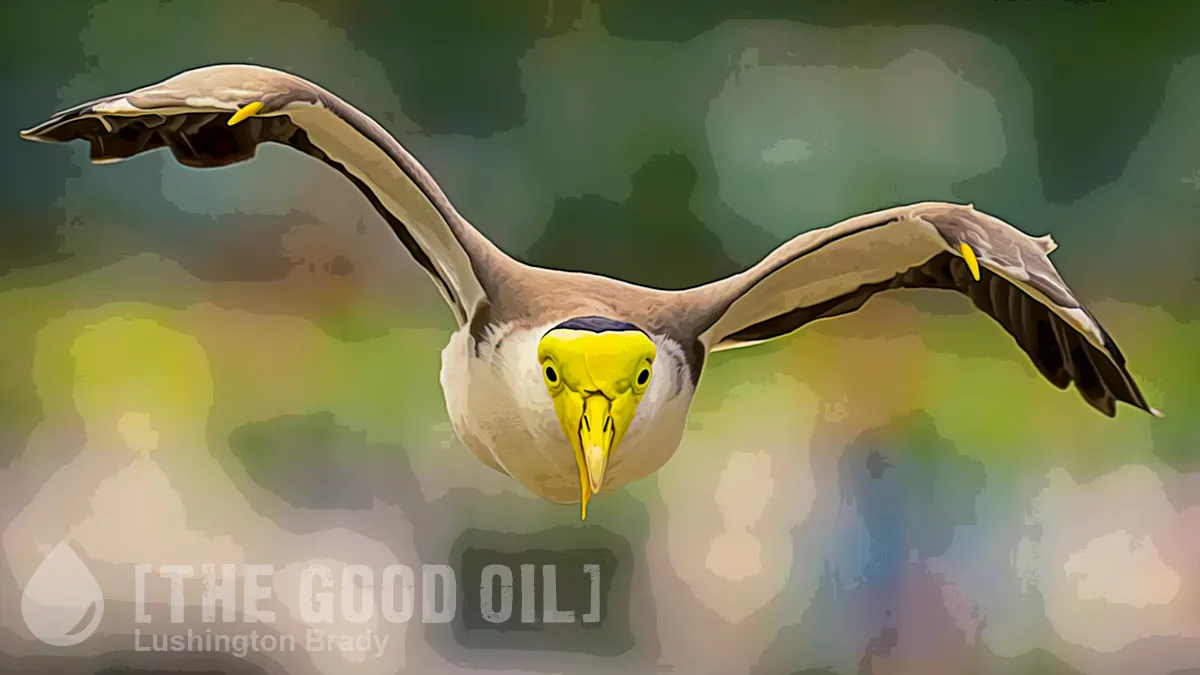I don’t know why so many foreigners live in terror of Australia’s wildlife. Sure, we’re home to six of the 10 most-venomous snakes in the world, three of the 10 most-venomous spiders, as well as sharks, crocodiles, blue-ringed octopus, stonefish, conefish and the Australian Greens.
Not to mention magpies.
Spring has sprung and for many Australians that means keeping an eye on the skies for the ever-looming threat of aerial bombardment.
For all the maggies’ swooping notoriety, I’ve never once been subject to such an attack. In fact, I find the birds rather endearing. Not just for their beautiful carolling in the morning, but their propensity for befriending humans, to the point of adopting trusted humans as babysitters for their fledglings. At least they’re not as mindlessly destructive as cockies – right bastards with a crackhead gleam in their beady eyes and a vandalistic streak wider than a group of teenagers.
As for swooping, magpies have nothing on the Murder Chickens (plovers, or masked lapwings, to the uninitiated). These shrieking psychos are armed with sharp spurs on their wings – and don’t they know it. To be fair, though, they also seem pretty cluey birds: they seem to be able to recognise who’s a threat and who’s not where they nest regularly. Though they’re generally merciless to dogs.
And besides, their chicks are fetching little fluffballs on stilt legs.

If choosing violence doesn’t do the job, lapwings, like other ground-nesting birds, have another trick up their wings: faking it.
“They’ll slip off the nest and move a few metres away, and then make themselves really obvious,” [Professor of animal behaviour at the University of New England Paul McDonald] said.
“They'll lie on their side and flap one wing independently, and it just looks weird, or like the animal is in distress.”
Dr McDonald said the animals then tried to lure predators away from the nest.
“Once they’ve reached a point that the nest is no longer noticeable and likely to be discovered, the adult will sit up and fly off perfectly healthy,” he said.
“It’s a really good distraction display.”
But swooping and malingering are not the only, and certainly the least disgusting, ways Australian birds will protect their nests.
[Dr McDonald] said many seabird hatchlings, particularly muttonbirds, would vomit on potential threats, including humans.
So, kind of like drunk hoodrats on public transport?
Dr McDonald said this was done by condensing partially digested food into an oily substance.
“As you can imagine it is very smelly and sticky. It coats the predators’ outer feathers and fur,” Dr McDonald said.
“[Muttonbirds] don’t do it all the time, obviously they are losing a meal. But it does work really well against their main predators like dogs and foxes.”
Around 23 million muttonbirds are found in 285 colonies in south-eastern Australia, many of them in Tasmania.
Well, turn and turn about, smoked muttonbird is a peculiar Tasmanian delicacy. One, I can say, I’ve yet to steel myself to try, however many times I see them in the local butcher’s window. Not even a muttonbird pie, thank you.
While muttonbirds and magpies work on the theory that offence is the best form of defence, the crested bellbird reinforces its defences.
The birds, which live in arid climates, line their cup-shaped nests with hairy caterpillars.
Dr McDonald said this was believed to be a way to drive off predators.
“Those caterpillars are quite spiky and an irritant. Most people have probably brushed up against one of them in the garden at some point,” he said.
If you’re really worried about Antipodean avian attacks, though, here’s what you can try, you big wuss.
Dr McDonald said […] the best way for anyone to avoid being attacked was to give any nesting bird plenty of space.
“Try and change your commute if you can, at least for a few weeks until the nesting is over,” he said.
“Put some signs up so people are aware of it.”
If you have to pass by the bird’s nest, the best advice is to remain calm.
“Don't speed up, change your path, or walk directly at the nest,” Dr McDonald said.
“Wear eye protection or a hat; most birds will swoop towards the face or head.
“It can help sometimes turn and face the bird … if you are walking backwards a little bit, to keep an eye on the bird, sometimes that can stop the swooping as well.”
Some cyclists even put googly eyes on the back of their helmets. Because cyclists don’t look stupid enough, already.
Anyway, I’ll be on the magpies’ side.








